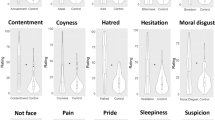Abstract
In this paper, we experimentally examined whether changes in the facial expressions of teleoperated androids could affect and regulate operators’ emotion, based on the facial feedback theory of emotion and the phenomenon of body ownership transfer to the robot. Twenty-six Japanese participants had conversations with an experimenter based on a situation where participants feel anger and, during the conversation, the android’s facial expression changed according to a pre-programmed scheme. The results showed that the facial feedback from the android did occur. Moreover, by comparing the two groups of participants, one with operating the robot and another without operating it, we found that this facial feedback from the android robot occur only when participants operated the robot and, when an operator could effectively operate the robot, his/her emotional states were much affected by facial expression change of the robot.







Similar content being viewed by others
Notes
This experiment was approved by the ethical committee of Advanced Telecommunications Research Institute International (No. 12-506-1).
We used the same affect scale for the pre-experiment questionnaire. However, the results of the pre-experiment questionnaire was not used in this study.
In this study, we only used the post-session results for analysis.
References
Averill JR (1983) Studies on anger and aggression: implications for theories of emotion. Am Psychol 38(11):1145–1160
Botherel V, Maffiolo V (2006) Regulation of emotional attitudes for a better interaction: field study in call centres. In: Proc. 20th international symposium of human factors in telecommunication
Botvinick M (1998) Rubber hands ’feel’ touch that eyes see. Nature 391(6669):756
Calvo RA, D’Mello S (2010) Affect detection: an interdisciplinary review of models, methods, and their applications. IEEE Trans Affect Comput 1(1):18–37
Derks D, Fischer AH, Bos AER (2008) The role of emotion in computer-mediated communication: a review. Comput Hum Behav 24(3):766–785
Frijda NH (1986) The emotions. Cambridge University Press, New York
Gross JJ (1998) The emerging field of emotion regulation: an integrative review. Rev Gen Psychol 2(3):271–299
Gross JJ (2002) Emotion regulation: affective, cognitive, and social consequences. Psychophysiology 39:281–291
Harris CR (2001) Cardiovascular responses of embarrassment and effects of emotional suppression in a social setting. J Pers Soc Psychol 81(5):886–897
Ishi CT, Liu C, Ishiguro H, Hagita N (2012) Evaluation of a formant-based speech-driven lip motion generation. In: 13th annual conference of the international speech communication association (Interspeech 2012), Portland, Oregon, p P1a. 04
Izard CE (1990) Facial expressions and the regulation of emotions. J Pers Soc Psychol 58(3):487–498
Kleinke C, Peterson T, Rutledge T (1998) Effects of self-generated facial expressions on mood. J Pers Soc Psychol 74:272–279
Lewis M, Haviland-Jones JM, Barrett LF (eds) (2008) Handbook of emotions. Guilford, New York
MacIntosh D (1996) Facial feedback hypotheses: evidence, implications, and directions. Motiv Emot 20:121–147
Nakanishi H (2004) Freewalk: a social interaction platform for group behaviour in a virtual space. Int J Hum-Comput Stud 60(4):421–454
Nishio S, Ishiguro H, Hagita NG (2007) Teleoperated android of an existing person. In: de Pina Filho AC (ed) Humanoid robots: new developments. I-Tech Education and Publishing, Vienna, pp 343–352
Nishio S, Watanabe T, Ogawa K, Ishiguro H (2012) Body ownership transfer to teleoperated android robot. In: International conference on social robotics (ICSR 2012), Chengdu, China, pp 398–407
Ogawa T, Monchi R, Kikuya M, Suzuki N (2000) Development of the general affect scales. Jpn J Psychol 71(3):241–246. (in Japanese)
Scherer KR, Ekman P (eds) (1984) Approaches to emotion. Erlbaum, New Jersey
Soussignan R (2002) Duchenne smile, emotional experience, and autonomic reactivity: a test of the facial feedback hypothesis. Emotion 2:52–74
Strack F, Martin L, Stepper S (1988) Inhibiting and facilitating conditions of the human smile: a nonobtrusive test of the facial feedback hypothesis. J Pers Soc Psychol 54:768–777
Zeng Z, Pantic M, Roisman GI, Huang TS (2007) A survey of affect recognition methods: audio, visual and spontaneous expressions. In: Proc. 9th international conference on multimodal interfaces, pp 126–133
Author information
Authors and Affiliations
Corresponding author
Additional information
This work was supported by KAKENHI (20220002) and KAKENHI (24650114).
Rights and permissions
About this article
Cite this article
Nishio, S., Taura, K., Sumioka, H. et al. Teleoperated Android Robot as Emotion Regulation Media. Int J of Soc Robotics 5, 563–573 (2013). https://doi.org/10.1007/s12369-013-0201-3
Accepted:
Published:
Issue Date:
DOI: https://doi.org/10.1007/s12369-013-0201-3




